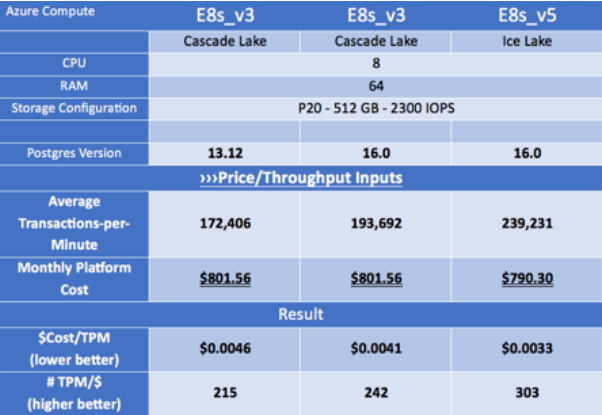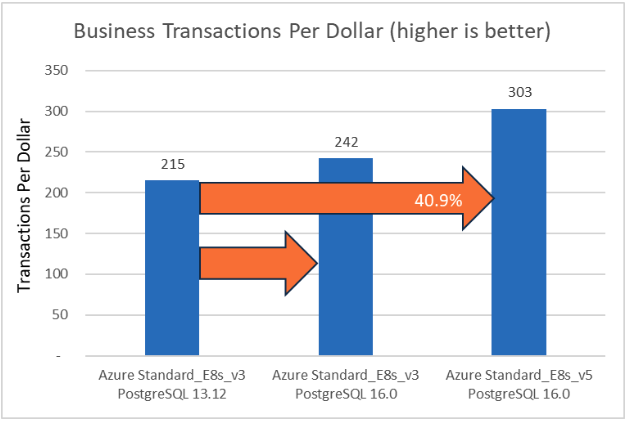Defining what ‘good’ looks like in technology is now more complicated than ever, especially in the area of relational databases. That’s why HammerDB created an open source tool that makes it easy to compare one database to another. This tool incorporates TPC-C—online transaction processing (OLTP) benchmarks from the Transaction Processing Performance Council—to measure transactions per minute.
In order to identify what the ‘BEST’ database combination is in Microsoft Azure from both a performance and price perspective, we worked with Intel to use HammerDB’s tool to evaluate a combination of Azure platforms. We compared transactions-per-minute (TPM) to determine the optimal Postgres and Intel database configuration.
We also compared the overall cost of components, and we mapped this to TPM to identify which platform resulted in the best cost-per-work. Because obtaining accurate results requires a maximum number of constants across platforms and minimal variables, we used EDB’s BigAnimal Database-as-a-Service as the Postgres platform, Azure P20 Premium SSD, and HammerDB v4.8 as constants in every comparison. We also compared these variables: Azure E8s_v3 – 8 vCPU with Intel(R) Xeon(R) CPU E5-2673 v4) Processors, Azure E8s_v5 – 8 vCPU with Intel(R) Xeon(R) Platinum 8370C Processors , and Postgres 16.0 and Postgres 13.12.
Platform Cost Comparison
When we compared database platforms on EDB’s BigAnimal running in the clients’ cloud (called Bring-Your-Own-Cloud BYOC), we found running the newer Postgres 16 on the newer Azure E8s_v5 instance had the lowest cost per month.
Platform Throughput Results
We also discovered that upgrading Postgres on the older Azure E8s_v3 instance results in a 12.3% throughput improvement. And upgrading the compute from Azure E8s_v3 to the newer Azure E8s_v5 results in an additional 23.5%. These upgrades resulted in a more than 40% improvement in overall throughput.
Combining Price with Throughput
The real value lies in combining the performance throughput from HammerDB (transactions-per-minute) and the monthly price for the platform. Here’s what we found when we compared these metrics:

And the Winner is…
We found that the optimal combination is Azure instance with Intel(R) Xeon(R) Platinum 8370C Processors and with Postgres 16. Combining these solutions resulted in a 40.9% cost advantage.

Why EDB’s Big Animal Database-as-a-Service?
We used EDB BigAnimal as a constant in our comparisons because this database-as-a-service built on Postgres provides a consistent multi-cloud (AWS, Azure and GCP) platform that enables our clients to retain control while benefiting from continuous innovations. It also enables enterprises to bring down costs in the cloud and increase efficiency with:
- Higher availability with unique advantages like multi-region active/active Postgres
- An advanced Postgres that offers added security and the ability to run Oracle workloads natively with no change
- Monitoring/management tooling to optimize and automate performance and stability
Learn more about EDB BigAnimal
As you can clearly see from this study, it pays to focus on throughput as well as price when considering cloud computing. Need help researching optimal database platform configurations for your enterprise? Contact us!
